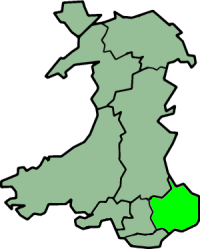Gwent (county)
Coordinates: 51°47′20″N 3°01′05″W / 51.789°N 3.018°W

Gwent is a preserved county and a former local government county in south-east Wales. It was formed on 1 April 1974, under the Local Government Act 1972, and was named after the ancient Kingdom of Gwent. The authority was a successor to both the administrative county of Monmouthshire (with minor boundary changes)[1] and the county borough of Newport, ending decisively a long period of discussion and doubt over whether the authorities were legally part of England or Wales before the Act came into force.[2][3][4]
Under the Local Government (Wales) Act 1994, Gwent was abolished on 1 April 1996.[5] However, it remains one of the preserved counties of Wales for the ceremonial purposes of Lieutenancy and High Shrievalty, and its name also survives in various titles, e.g. Gwent Police, Royal Gwent Hospital, Gwent Wildlife Trust, Coleg Gwent and the Newport Gwent Dragons rugby team. "Gwent" is sometimes used as a synonym for the historic county of Monmouthshire — for example the Gwent Family History Society describes itself as "The key to roots in the historic county of Monmouthshire".[6]
The former administrative county was divided into several districts: Blaenau Gwent, Islwyn, Monmouth, Newport and Torfaen. The successor unitary authorities are the Blaenau Gwent County Borough, Caerphilly County Borough (part of which came from Mid Glamorgan), Monmouthshire (which covers the eastern 60% of the historic county), City of Newport and Torfaen County Borough.
In 2003 the preserved county of Gwent expanded to include the whole of Caerphilly County Borough;[7] the Gwent Police area had already been realigned to these boundaries in 1996. In 2007, the population of this enlarged area was estimated as 560,500,[8] making it the most populous of the preserved counties of Wales.
See also
- List of Lord Lieutenants of Gwent
- List of High Sheriffs of Gwent
- Gwent Police
- Gwent Police and Crime Commissioner
References
- ↑ Less the parish of St Mellons and urban districts of Bedwas and Machen, Rhymney and part of Bedwellty and the addition of the parishes of Llanelly and Brynmawr.
- ↑ Local Government Act 1972 c. 70, s. 1 New local government areas in England, ss. 12 'In this section "England" does not include the administrative county of Monmouthshire or the county borough of Newport.' & s. 20 New local government areas in Wales, ss. 7 'In this section "Wales" includes the administrative county of Monmouthshire and the county borough of Newport.'
- ↑ Williams, Chris (2011). "The Question of Monmouthshire". In Williams, Chris; Williams, Sian Rhiannon. Industrial Monmouthshire 1780-1914. The Gwent County History. 4. Cardiff: University of Wales Press. p. 357. ISBN 978-0-7083-2365-6. OCLC 56570946.
- ↑
- Hopkins, Tony (Summer 1991). "In search of Monmouthshire, 1536-1972". Gwent local history; the journal of Gwent Local History Council (71): 8–12. Retrieved 11 May 2016 – via Welsh Journals Online at the National Library of Wales.
- ↑ "Local Government (Wales) Act 1994 c. 19, s. 1(1)". 5 July 1994.
- ↑ "Gwent Family History Society". Retrieved 2010-09-11.
- ↑ "The Preserved Counties (Amendment to Boundaries) (Wales) Order 2003". Office of Public Sector Information. 2003-04-01. Retrieved 2010-09-11.
- ↑ 2007 population estimate, calculated using 2003 borders for Blaenau Gwent, Caerphilly, Monmouthshire, Newport, Torfaen. Source: "Table 10: Mid-2006 to Mid-2007 Population Estimates, Components of population change for local authorities in the United Kingdom". Office for National Statistics. Retrieved 2010-09-11.
External links
- Ralph A. Griffiths, general editor, Gwent County History, University of Wales, 5 vols, 2004 —